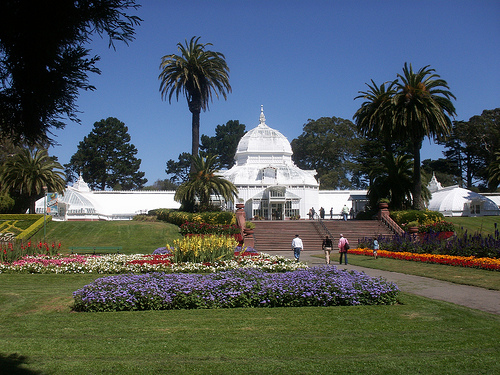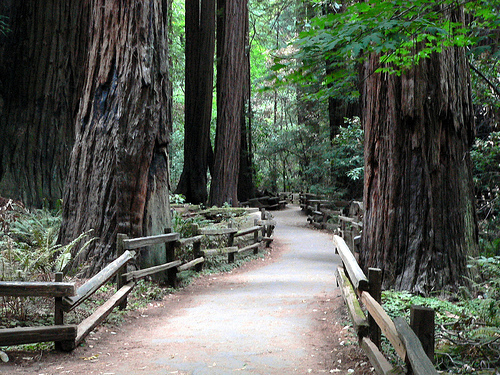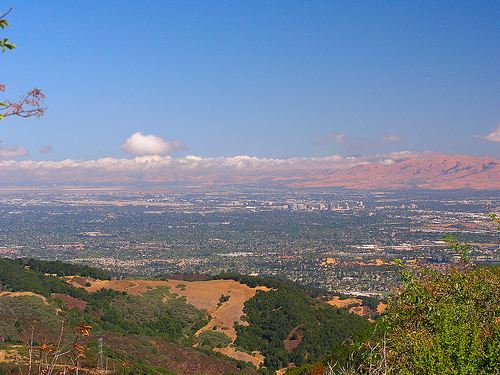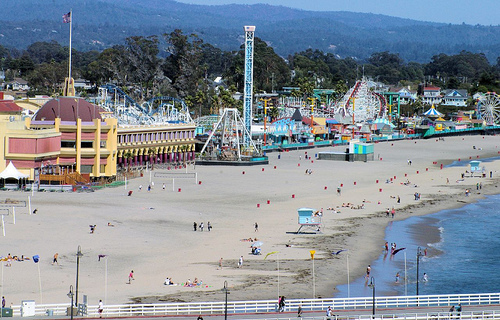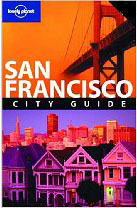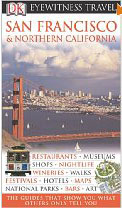Tourism in Northern California
For those of you who haven’t been to San Francisco before, or don’t visit often, here are some of the popular things to see and do in the city and surrounding area. Many of these are regular stops on Kevin's popular see-the-city-in-a-day driving tour -- but we don't recommend you try to catch them all in one day. That would be crazy.
We can provide additional advice on any of these sites, or the dozens more that we didn't list below. There is definitely no shortage of interesting activities in the area.
- Fisherman's Wharf and North Beach
- Downtown, Financial District, and SOMA
- Haight-Ashbury, Mission, and Castro Districts
- Pacific Heights and The Marina District
- Golden Gate, Presidio, and Lincoln Park
- Marin, Sausalito, and Points North
- San Jose, Santa Cruz, Monterey, and Points South
- Yosemite, Lake Tahoe, and Points East
- And more...
Note that each of the underlined titles below are links to additional information.
Fisherman’s Wharf and North Beach
Alcatraz
The infamous federal penitentiary was in operation from 1934 to
1963 and has been the site of some great stories and movies.
Alcatraz may seem like one of those cliché touristy things to do while you’re
here, and it is -- but a trip to The Rock is worthwhile.
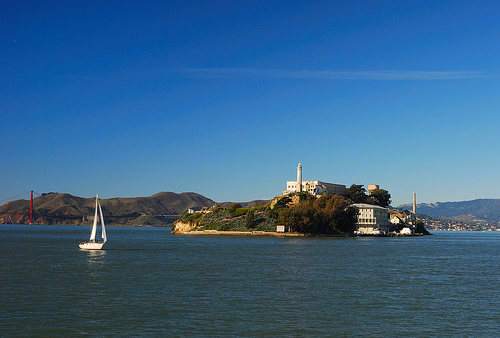 They reworked the tour a few years ago -- now you listen to a guided tour up to
the cellblock, then you strap on the
provided headphones, start the audio, and walk around at your own
pace. A word of caution: the tours often sell out, sometimes months
in advance, so it is wise to buy tickets in advance if you wish to go.
The ferries depart next to Pier 39 in Fisherman's Wharf. They also provide a night tour for those who want
to experience the jailhouse in the dark -- the view of the city is amazing.
They reworked the tour a few years ago -- now you listen to a guided tour up to
the cellblock, then you strap on the
provided headphones, start the audio, and walk around at your own
pace. A word of caution: the tours often sell out, sometimes months
in advance, so it is wise to buy tickets in advance if you wish to go.
The ferries depart next to Pier 39 in Fisherman's Wharf. They also provide a night tour for those who want
to experience the jailhouse in the dark -- the view of the city is amazing.
Pier 39
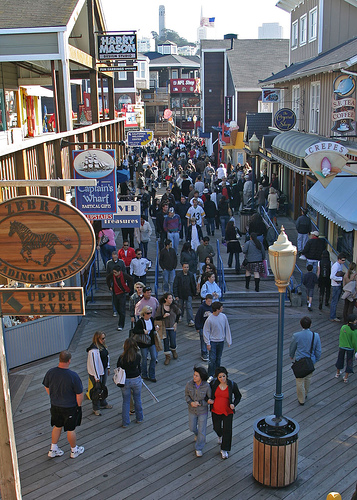 Home to entertainment, shopping, dining,
and high-priced clam chowder served in a classic sourdough bread bowl. Lots of fun with the kids, including a carousel, interactive arcade,
aquarium, and an entertainment stage toward the end of the pier featuring magic and juggling shows.
Don’t miss the famously loud
California sea lions at the end of the pier to the left-hand side. The entire area of the wharf nearby is dedicated to consumer tourism, so you
may love it or hate it.
Home to entertainment, shopping, dining,
and high-priced clam chowder served in a classic sourdough bread bowl. Lots of fun with the kids, including a carousel, interactive arcade,
aquarium, and an entertainment stage toward the end of the pier featuring magic and juggling shows.
Don’t miss the famously loud
California sea lions at the end of the pier to the left-hand side. The entire area of the wharf nearby is dedicated to consumer tourism, so you
may love it or hate it.
Ghirardelli Square
Shopping, waterfront dining, entertainment, and the smell of chocolate. We'd rather head to the Ferry Building for specialty local chocolates, but Ghirardelli chocolate is known the world over as a San Francisco treat since 1852. The building is a beautifully restored outdoor mall of boutique stores and several restaurants with great views of the Bay. At the Ghirardelli Ice Cream and Chocolate Shop you can view the original chocolate manufacturing equipment, indulge in Hot Fudge Sundaes, and sample one of their famous Chocolate Squares.
Ferry Building
Opening in 1898 on the site of the 1875 wooden Ferry House, the Ferry Building became the transportation focal point for anyone arriving by train from the East, or from the ferries transporting the East Bay and Marin residents who worked in the city.
From the Gold Rush until the 1930s, arrival by ferryboat became the only way travelers and commuters—except those coming from the Peninsula—could reach the city. The present structure survived both the 1906
earthquake and the 1989 earthquake with amazingly little damage. Until the completion of the Bay Bridge and Golden Gate Bridge in the 1930s it was the second busiest transit terminal in the world, second only to London's Charing
Cross Station. In 2004, the building reopened as an upscale gourmet marketplace,
office building, and re-dedicated ferry terminal. The restoration project
spanned several years, with an emphasis on recreating the building's 1898
ambience.
or from the ferries transporting the East Bay and Marin residents who worked in the city.
From the Gold Rush until the 1930s, arrival by ferryboat became the only way travelers and commuters—except those coming from the Peninsula—could reach the city. The present structure survived both the 1906
earthquake and the 1989 earthquake with amazingly little damage. Until the completion of the Bay Bridge and Golden Gate Bridge in the 1930s it was the second busiest transit terminal in the world, second only to London's Charing
Cross Station. In 2004, the building reopened as an upscale gourmet marketplace,
office building, and re-dedicated ferry terminal. The restoration project
spanned several years, with an emphasis on recreating the building's 1898
ambience.
San Francisco's largest farmers market is held here on Tuesdays and Saturdays year-round and Thursday evenings in the summer, so a trip here Saturday morning before the wedding is highly recommended since it is within easy walking distance of the hotel. Even better, some of the market merchants also provide cooked breakfasts.
North Beach
Originally named for a beach that became landfill in the 1800's, North Beach is the location of the historical Little Italy, Barbary Coast, and Bohemian/Beatnik areas that were home to the beat poets such as Jack Kerouac and Allen Ginsberg in the 1950's. The neighborhood is filled with interesting little shops and restaurants and is a very popular walking area -- especially since it can be next to impossible to find street parking on the narrow hilly streets.
Coit Tower
Sitting high on Telegraph Hill, the iconic tower was built in 1933 with funds donated to the city by
Lillie Hitchcock Coit.
She had a special relationship with the city's
firefighters, having been rescued from a fire at the age of eight.
By the age of fifteen, she was riding the Knickerbocker Engine Co.
5. and as an adult was recognized as an honorary firefighter.
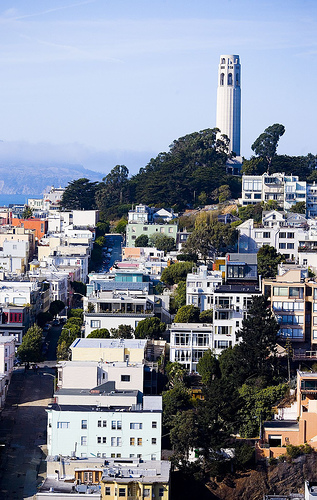 You'll often hear tour guides and others claiming that Coit Tower
is supposed to look like the nozzle of a fire hose, but the
architects had always denied it, and in fact, it looks more like the
towers at London's Battersea Power Station, completed one year
earlier. There was also the persistent rumor that the
tower was a giant storage tank filled with tomato sauce and
connected to the Italian restaurants in North Beach by secret
underground pipelines.
Views from the observation deck are incredible, especially at sunset.
Not to be missed are the murals decorating the lobby, considered to be one of California's best examples
of depression-era public art. Part of a Public Works of Art Project, they were painted in 1934 by 25 artists.
Done in Diego Rivera's social realism style, they are sympathetic portrayals of the daily life of working class
Californians during the depression. Because some people felt the murals were subversive and depicted "Communist"
themes, the authorities delayed the opening of Coit Tower for several months.
Note: The road up Telegraph Hill to Coit Tower is often congested during the summer with cars waiting to reach the top,
where parking is extremely limited. Public transportation, or an exhilarating hike up the neighborhood stairs, is strongly recommended.
On a quiet day, listen for the calls of the famous Wild Parrots of Telegraph Hill
(see the
movie), a
flock of beautiful birds who make their home
in the area.
You'll often hear tour guides and others claiming that Coit Tower
is supposed to look like the nozzle of a fire hose, but the
architects had always denied it, and in fact, it looks more like the
towers at London's Battersea Power Station, completed one year
earlier. There was also the persistent rumor that the
tower was a giant storage tank filled with tomato sauce and
connected to the Italian restaurants in North Beach by secret
underground pipelines.
Views from the observation deck are incredible, especially at sunset.
Not to be missed are the murals decorating the lobby, considered to be one of California's best examples
of depression-era public art. Part of a Public Works of Art Project, they were painted in 1934 by 25 artists.
Done in Diego Rivera's social realism style, they are sympathetic portrayals of the daily life of working class
Californians during the depression. Because some people felt the murals were subversive and depicted "Communist"
themes, the authorities delayed the opening of Coit Tower for several months.
Note: The road up Telegraph Hill to Coit Tower is often congested during the summer with cars waiting to reach the top,
where parking is extremely limited. Public transportation, or an exhilarating hike up the neighborhood stairs, is strongly recommended.
On a quiet day, listen for the calls of the famous Wild Parrots of Telegraph Hill
(see the
movie), a
flock of beautiful birds who make their home
in the area.
Downtown, Financial District, SOMA
Chinatown
San Francisco's Chinatown is the oldest Chinatown in North America,
and is the largest Chinese community outside of Asia. Chinatown became established in the mid 1800’s when there was a large boom in
Chinese immigration to the
 United States. Most entered as laborers and went to work on the railroad system, while
others were drawn by the gold being discovered in California and became
miners. At the time, the bay came up as far as Montgomery Street, so the
location of Chinatown was the port of entry for the bulk of those immigrants.
The current look of Chinatown came after the 1906 earthquake. Because Chinatown
at the time of the quake was mostly wooden shacks, the area was almost
completely demolished and needed to be rebuilt. This time it was built to be a tourist attraction
to attract western tourists. Though some of the
architecture may not be true Chinese, the food, culture and people continue to
bring authenticity back to the area. For the traditional tourist that is going to
Chinatown to eat and shop, you won’t be disappointed. If you want
souvenirs, you’ll find plenty here. The most concentrated area for
souvenirs and knickknacks is near the Chinatown gate on Grant
Street, but you’ll see more as you walk the many side streets.
United States. Most entered as laborers and went to work on the railroad system, while
others were drawn by the gold being discovered in California and became
miners. At the time, the bay came up as far as Montgomery Street, so the
location of Chinatown was the port of entry for the bulk of those immigrants.
The current look of Chinatown came after the 1906 earthquake. Because Chinatown
at the time of the quake was mostly wooden shacks, the area was almost
completely demolished and needed to be rebuilt. This time it was built to be a tourist attraction
to attract western tourists. Though some of the
architecture may not be true Chinese, the food, culture and people continue to
bring authenticity back to the area. For the traditional tourist that is going to
Chinatown to eat and shop, you won’t be disappointed. If you want
souvenirs, you’ll find plenty here. The most concentrated area for
souvenirs and knickknacks is near the Chinatown gate on Grant
Street, but you’ll see more as you walk the many side streets.
Museum of Modern Art (SF MoMA)
The San Francisco Museum of Modern Art is one of the top modern art museums in the country. The SFMOMA also sits inside one of the most interesting buildings in the South of Market Area (SOMA). The permanent collection includes works by Pollack, Warhol, Matisse, Picasso and O’Keeffe, as well as artists with a connection to the Bay Area, such as Diebenkorn and Thiebaud. Nearby you'll also find the Yerba Buena Center for the Arts and the Contemporary Jewish Museum.
Union Square
San Francisco’s primary shopping district, with all the big stores within a few blocks of each other:
Macy’s, Saks, Nordstrom, Neiman Marcus, Williams Sonoma, Tiffany, Borders, Niketown, Levi’s, and Luis Vuitton.
San Francisco Centre, the largest urban shopping center west of the Mississippi,
is nearby in the old Emporium building complex -- they restored the beautiful
102 foot dome and rotunda of the original 1908 building.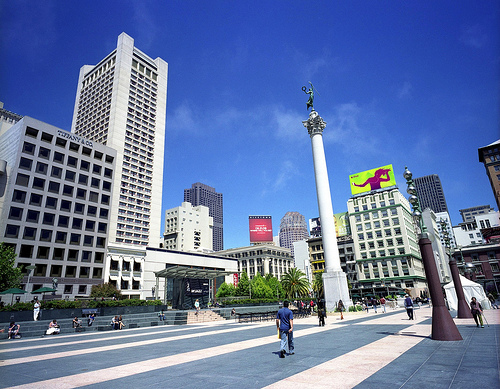
Sutter, Post, and Geary streets are filled with fine art galleries, some focusing on selling works by big names like Picasso and Chagall, and others devoted to exhibiting works by contemporary artists. San Francisco's only Frank Lloyd Wright building, built in 1949 and currently housing the Xanadu Gallery, is located at 140 Maiden Lane, and features the same circular interior as the famed Guggenheim Museum in New York.
This is also San Francisco's main theater district, with some historic, beautiful buildings housing the performances. Shows range from traveling Broadway and off-Broadway shows on limited runs to smaller local productions.
Cable Cars and Museum
All Kevin knew about San Francisco before moving here was Alcatraz, the cable
cars, and that annoying
Rice-a-Roni jingle. A visit to the city is not complete if you don't
catch at least one ride on one of the three remaining cable car lines. The
first cable cars were installed in the 1870's to relieve the poor horses who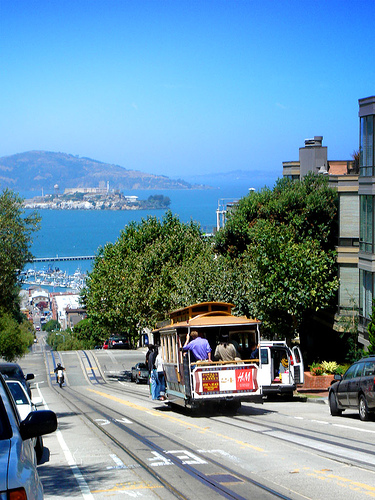 were forced to pull wagons and carriages up the steep hills -- the idea came
from the cable system that was used to haul ore from the gold mines. At
their height of use in the 1890's there were 53 miles of cable car tracks laid
throughout the city. Over the years the earthquakes, electric trolleys,
and automobiles led to the city considering removing the cable cars due to
operating and maintenance costs.
They were saved by a public campaign (started by a little old lady), and of course like anything else in the
city, by a ballet initiative. The remaining three lines were
completely rebuilt in the early 1980's, including restoring many of the original
cars. The three remaining lines are the Powell-Hyde, Powell-Mason, and
California routes. Fares are $5 each way and a one-day pass is $11, each
of which can be purchased by a conductor or at the usually busy turnaround
locations at the end of the lines. There is also an excellent museum (free) at 1201 Mason, one of
the original (and still operating) cable car power stations.
were forced to pull wagons and carriages up the steep hills -- the idea came
from the cable system that was used to haul ore from the gold mines. At
their height of use in the 1890's there were 53 miles of cable car tracks laid
throughout the city. Over the years the earthquakes, electric trolleys,
and automobiles led to the city considering removing the cable cars due to
operating and maintenance costs.
They were saved by a public campaign (started by a little old lady), and of course like anything else in the
city, by a ballet initiative. The remaining three lines were
completely rebuilt in the early 1980's, including restoring many of the original
cars. The three remaining lines are the Powell-Hyde, Powell-Mason, and
California routes. Fares are $5 each way and a one-day pass is $11, each
of which can be purchased by a conductor or at the usually busy turnaround
locations at the end of the lines. There is also an excellent museum (free) at 1201 Mason, one of
the original (and still operating) cable car power stations.
Haight-Ashbury, Mission, and Castro Districts
Mission Dolores
Mission Dolores is the oldest building in San Francisco and one of the oldest missions in California. In addition to the
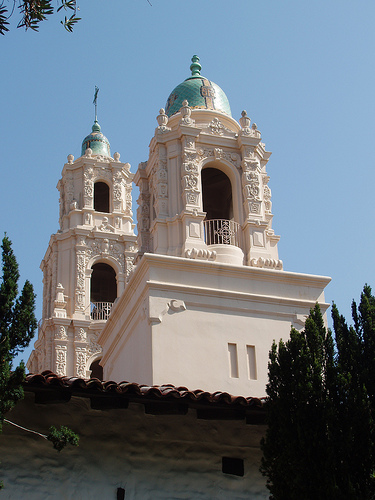 glorious, intricate detail in its stained glass, alter, and murals, the Mission also includes a museum and historic graveyard. This mission is one of the many famous SF scenes appearing in Alfred Hitchcock’s movie, Vertigo. Be sure to walk two blocks south of the Mission to Dolores Park, walk to the top of the park, and enjoy glorious views of downtown.
glorious, intricate detail in its stained glass, alter, and murals, the Mission also includes a museum and historic graveyard. This mission is one of the many famous SF scenes appearing in Alfred Hitchcock’s movie, Vertigo. Be sure to walk two blocks south of the Mission to Dolores Park, walk to the top of the park, and enjoy glorious views of downtown.
Twin Peaks
Known for its unparalleled, 360 degree views of the City and the Bay, a visit to the top of Twin Peaks (the tallest of San Francisco's hills) is well worth the trip. They can be accessed by car or a very steep hike for those looking for a great workout. If the thick fog is in, don’t bother going up to Twin Peaks -- you won’t see more than ten feet in front of you. But it is a great place to buy San Francisco sweatshirts, with multiple stands arranged to clothe the freezing tourists in shorts who just got off their tour bus.
Haight Ashbury
Discover why San Francisco’s vibrant Haight-Ashbury, rich with history and Vicorian houses was home to free love, rock ‘n’ roll communes, and cults during the colorful ’60’s. Now you can find lots of second-hand clothing stores, used CD exchanges, and the occassional tie-dyed shirt. The Hippy Gourmet offers a two-hour walking tour of the history and architecture at 9:30am on Tuesday and Saturday and 11:00am on Fridays. In addition, the annual Haight Ashbury Street Fair will be held on the Sunday after our wedding if you're still in town. Also, some of the most colorful Victorian homes in the city can be found in the area.
The Castro
The Castro is the center of the San Francisco gay community. If you decide to stay in the city another week you can catch the Gay Pride celebration and parade -- it is unlike any parade you've ever seen. Otherwise the area is filled with unusual restaurants and shops, and a very active gay nightlife.
Pacific Heights and The Marina District
The Marina district, like many areas of the city, is actually built on landfill from the 1906 earthquake. When all the buildings collapsed, they needed somewhere to pile the rubble. Soon after the new waterfront "land" was created, San Francisco hosted the 1915 Pan Pacific Expo. Since the area is landfill, it was the hardest hit during the 1989 Loma Prieta earthquake when the ground turned to jello and rocked many buildings to the ground.
Fillmore Street
Part jazz and part java, the clubs and coffeehouses of Fillmore Street combine for a day-long adventure. During the summer and fall, “Fillmore Fridays” bring out the best of local jazz artists to the Fillmore Preservation Jazz District, and the nearby patisseries, cafes, and bistros couples with an alluring mix of boutiques and galleries are a year round draw.
Palace of Fine Arts
Created as the landmark building for the 1915 Panama-Pacific
International Exposition, the Palace of Fine Arts is indisputably the Marina's
(if not all of San Francisco's) architectural grand dame.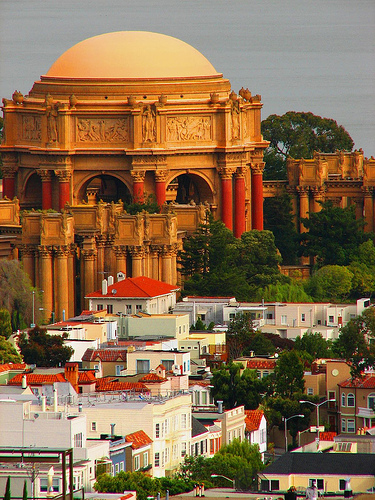 Though the structure was specifically designed to honor the completion of the
Panama Canal (and was intended to be temporary), its construction and the
exposition itself were symbols to city residents and to the world that San
Francisco had overcome -- and in fact risen above -- the catastrophe of the 1906
earthquake and its consuming fire. Originally built to deteriorate after a
year (it was originally made of plaster), the structure was restored soon after
the Exposition. Today the Palace of Fine Arts is home to one of the city's
most interesting museums, the
Exploratorium. This highly interactive science museum offers a
multitude of learning opportunities for kids and adults.
Though the structure was specifically designed to honor the completion of the
Panama Canal (and was intended to be temporary), its construction and the
exposition itself were symbols to city residents and to the world that San
Francisco had overcome -- and in fact risen above -- the catastrophe of the 1906
earthquake and its consuming fire. Originally built to deteriorate after a
year (it was originally made of plaster), the structure was restored soon after
the Exposition. Today the Palace of Fine Arts is home to one of the city's
most interesting museums, the
Exploratorium. This highly interactive science museum offers a
multitude of learning opportunities for kids and adults.
Pacific Heights
Explore tony Pacific Heights where tour buses are prohibited. The
neighborhood was first developed in the 1870s with small Victorian homes, but
near the turn of the century (after the 1906 earthquake and 1915 exposition),
many were replaced with period homes. Still residential, the area is
characterized by painted Victorians, chateaus, and mansions. It is
interesting seeing how narrow many houses in the city were built -- it makes
perfect sense when you understand the topology.
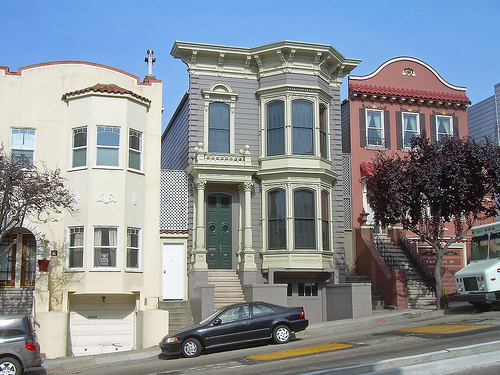 Many international consulates are located in Pacific Heights, including the
consulate generals of Russia, Greece, Egypt, Vietnam, Italy, Germany, France,
and Norway. There are a number of
walking tours
where you can view classical Victorian homes and famous mansions. For a
quintessential Pacific Heights moment, descend the Broadway & Lyon street steps
between beautiful homes and the Presidio. From the hedge garden you can
glimpse the Palace of the Fine Arts and the expands of the Bay below.
Many international consulates are located in Pacific Heights, including the
consulate generals of Russia, Greece, Egypt, Vietnam, Italy, Germany, France,
and Norway. There are a number of
walking tours
where you can view classical Victorian homes and famous mansions. For a
quintessential Pacific Heights moment, descend the Broadway & Lyon street steps
between beautiful homes and the Presidio. From the hedge garden you can
glimpse the Palace of the Fine Arts and the expands of the Bay below.
The Golden Gate, The Presidio, and Lincoln Park
Golden Gate Park
Golden Gate Park is a large urban park consisting of 1017 acres. Configured as a rectangle,
it is similar in shape but 174 acres larger than Central Park in New York, to which it is often compared. With 13 million visitors annually,
Golden Gate is the third most visited city park in The United States (after Central Park and Lincoln Park in Chicago).
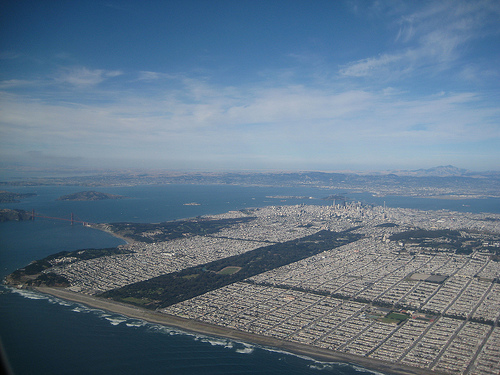
In
1870 ¾ of the park
was covered in ocean dunes, but they were soon blanketed with various tree plantings. By 1875, the area bloomed with close to 60,000 trees, such as the Blue Gum
Eucalyptus and the Monterey Pine. Four years later, 155,000 additional trees were placed over 1,000 acres of land. In 1903, the Dutch Windmills found their home at the western
end of the park with an initial duty to pump water throughout the park.
Over the years, Golden Gate Park has seen the establishment of a number of
interesting and entertaining attractions.
Conservatory of Flowers
The Conservatory of Flowers, the oldest remaining municipal wooden conservatory in the United States, was originally found in crates amongst the belongings of James Lick, the richest man in California when he died in 1873. Thousands of plants and flowers as well as special exhibits are housed in this stunning structure, resembling a large glass birdcage. The Conservatory also houses one of the world’s most notable collection of orchids. In 1995, a major storm with 100 mph winds wreaked havoc on the building, shattering 40% of the glass, until it was once again reopened in 2003 after a $25 million dollar reconstruction.
California Academy of Sciences
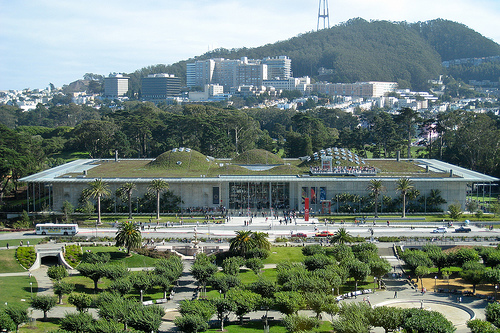 The California Academy of Sciences is one of the largest natural history museums in the world
and has also been a premier research institution for over 155 years. The museum carries exhibits of
reptiles and amphibians, astronomy, prehistoric life, various gems and minerals,
earthquakes, and aquatic life.
The California Academy of Sciences is one of the largest natural history museums in the world
and has also been a premier research institution for over 155 years. The museum carries exhibits of
reptiles and amphibians, astronomy, prehistoric life, various gems and minerals,
earthquakes, and aquatic life.
Severely damaged in the 1989 earthquake,
the museum reopened in the fall of 2008. The beautiful new building houses
40,000 animals, an aquarium, a state-of-the-art planetarium, and a four-story rain forest -- all
under a living roof. We still haven't visited the new building because the lines are
always so long.
Japanese Tea Garden
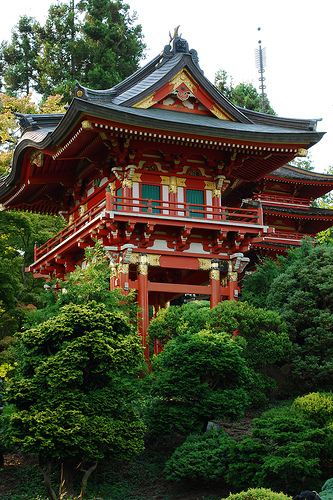 The
de Young's next-door neighbor, the Japanese Tea Garden, has been a fixture in
Golden Gate Park since 1894, and is the oldest public Japanese garden in the
United States. The garden, built for the Japanese Village exhibit in the 1894 California
Midwinter International Exposition, was designed by Makoto Hagiwara, whose family ran it from
1907 until the internment of Japanese Americans in World War II. The Garden, with its five landscaped acres,
features bridges, streams, waterfalls, sculpture, traditional Japanese architecture, and a tea house.
One oral history from the great-great-grandson of Makoto I found
online
described how a sea lion escaped from the nearby Academy of Sciences and ate all the goldfish in the garden.
The
de Young's next-door neighbor, the Japanese Tea Garden, has been a fixture in
Golden Gate Park since 1894, and is the oldest public Japanese garden in the
United States. The garden, built for the Japanese Village exhibit in the 1894 California
Midwinter International Exposition, was designed by Makoto Hagiwara, whose family ran it from
1907 until the internment of Japanese Americans in World War II. The Garden, with its five landscaped acres,
features bridges, streams, waterfalls, sculpture, traditional Japanese architecture, and a tea house.
One oral history from the great-great-grandson of Makoto I found
online
described how a sea lion escaped from the nearby Academy of Sciences and ate all the goldfish in the garden.
Golden Gate Bridge
The Golden Gate Bridge is one of the most recognizable landmarks in the world
-- you know this by the number of times it's been destroyed by tidal waves,
earthquakes, and aliens in the movies. Before its completion in 1937,
the bridge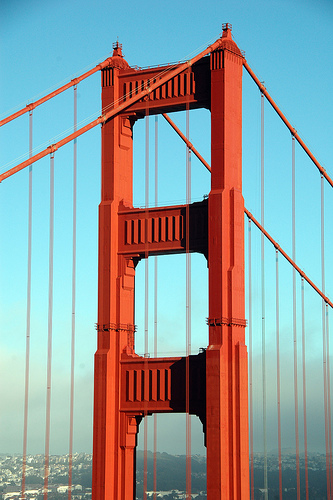 was considered impossible to build, due to persistently foggy weather, 60-mile-per-hour winds, and strong
ocean currents which whipped through a deep canyon below. In fact, the bridge is commonly known as the "bridge that
couldn't be built." Despite these unforgiving natural elements, the bridge was constructed in a little more than four
years at a total cost of $35 million. The total length of the bridge spans 1.7 miles, and eleven men lost their lives during
its construction. Even today, the massive spans of the bridge are often shrouded in fog. The bridge sways 27 feet to withstand winds of up to
100 miles per hour. International Orange was the color chosen for the bridge because it blended well with the bridge's
natural surroundings and for its visibility in the fog. The two great cables extending from the bridge contain 80,000 miles of steel wire, which is enough
to circle the equator three times. The concrete poured to cement the bridge into the
cold waters below could have also
been used to pave a five-foot sidewalk from New York to San Francisco.
There is a vista lookout at the north end of the bridge, but many people also
park at the south end and walk to the center.
was considered impossible to build, due to persistently foggy weather, 60-mile-per-hour winds, and strong
ocean currents which whipped through a deep canyon below. In fact, the bridge is commonly known as the "bridge that
couldn't be built." Despite these unforgiving natural elements, the bridge was constructed in a little more than four
years at a total cost of $35 million. The total length of the bridge spans 1.7 miles, and eleven men lost their lives during
its construction. Even today, the massive spans of the bridge are often shrouded in fog. The bridge sways 27 feet to withstand winds of up to
100 miles per hour. International Orange was the color chosen for the bridge because it blended well with the bridge's
natural surroundings and for its visibility in the fog. The two great cables extending from the bridge contain 80,000 miles of steel wire, which is enough
to circle the equator three times. The concrete poured to cement the bridge into the
cold waters below could have also
been used to pave a five-foot sidewalk from New York to San Francisco.
There is a vista lookout at the north end of the bridge, but many people also
park at the south end and walk to the center.
The Presidio & Crissy Field
Not only can you find breathtaking views from many spots within the Presidio, the current national park also has a rich history.
The original el Presidio was established
by the Spanish as the northernmost outpost of colonial New Spain (Mexico). With
Mission San Francisco de Asis (Mission Dolores), and the later pueblo at Yerba
Buena Cove, these three early settlements marked the genesis of the City of San
Francisco. Used as a military post for Spain, Mexico and the United States
since 1776, the Presidio is a 1500 acre compound including miles of hiking and
biking trails and various buildings and fortifications of military significance.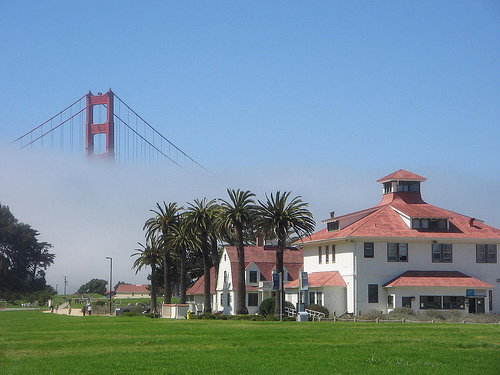
The Sixth US Army turned over the fort in 1994 to the National Park Service and the Presidio Trust, which was formed to oversee the management of the park lands. Lucasfilms (Star Wars) moved its headquarters to the park in 2005 in case you wanted to visit the Yoda fountain.
If you’re looking for a walk or jog or bike ride along the Bay, head to Crissy Field. Start at the Marina Green, stroll past sailboarders in the Bay, all with unobstructed views of the Golden Gate Bridge. Enjoy the results of a recent $34 million environmental restoration by the Golden Gate National Parks Association. The former military airfield now offers picnic areas, beach access, a restored tidal marsh, a marine sanctuary, and a large plot of coastal open space.
Fort Point
Most people are surprised when you tell them that there is a Civil War fort located underneath the Golden Gate Bridge.
Fort Point was built between 1853 and 1861 by the U.S. Army
Engineers as part of a defense system of forts planned for the
protection of San Francisco Bay. Designed at the height of the Gold
Rush,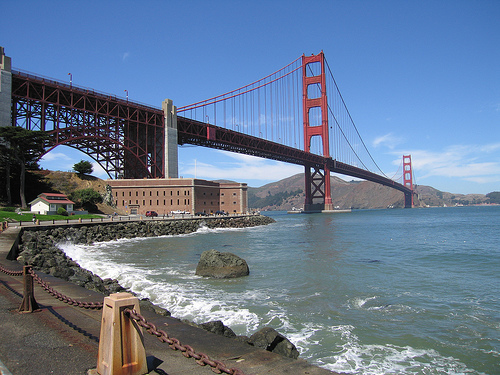 the fort and its companion fortifications would protect the Bay’s
important commercial and military installations against foreign
attack. Thankfully the fort never had to fire its cannons.
In the late 1930s, plans for the construction of the Golden Gate
Bridge involved plans for the demolition of Fort Point.
Fortunately, Chief Engineer Joseph Strauss recognized the
architectural value of the Fort and created a specially engineered
arch which allowed the construction of the bridge to occur safely
over the fort. Now a National Historical Site, the fort is
open Friday through Sunday for exploration and tours.
the fort and its companion fortifications would protect the Bay’s
important commercial and military installations against foreign
attack. Thankfully the fort never had to fire its cannons.
In the late 1930s, plans for the construction of the Golden Gate
Bridge involved plans for the demolition of Fort Point.
Fortunately, Chief Engineer Joseph Strauss recognized the
architectural value of the Fort and created a specially engineered
arch which allowed the construction of the bridge to occur safely
over the fort. Now a National Historical Site, the fort is
open Friday through Sunday for exploration and tours.
Legion of Honor Museum
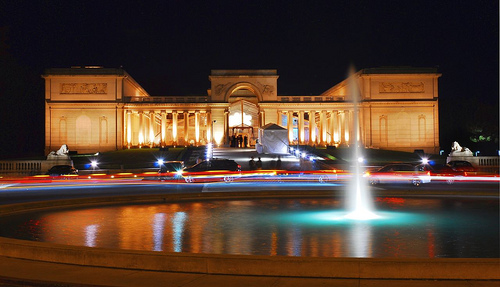 Built to commemorate Californian soldiers who died in World War I, the Legion of Honor is a beautiful Beaux-arts
building located in San Francisco's Lincoln Park. Overlooking the Pacific Ocean, Golden Gate Bridge and all of
San Francisco, the Legion is most noted for its breathtaking setting. Its collections include Rodin's Thinker and
a large collection of his other works, European decorative arts and paintings, ancient art, and one of the
largest collections of prints and drawings in the country.
Built to commemorate Californian soldiers who died in World War I, the Legion of Honor is a beautiful Beaux-arts
building located in San Francisco's Lincoln Park. Overlooking the Pacific Ocean, Golden Gate Bridge and all of
San Francisco, the Legion is most noted for its breathtaking setting. Its collections include Rodin's Thinker and
a large collection of his other works, European decorative arts and paintings, ancient art, and one of the
largest collections of prints and drawings in the country.
Marin, Sausalito, and Points North
Just across the Golden Gate Bridge, Marin County is San Francisco's picturesque playground. From misty, redwood-dense coasts to the sharp heights of Mt. Tamalpais, Marin County is an inspirational place. Marin's secluded state and national parks, such as Mt. Tamalpais, Pt. Reyes National Seashore, Muir Woods, and Marin Headland offer a natural escape from the urban San Francisco.
Marin's small towns, especially the quaint little bayside port towns of Tiburon and Sausalito, are in full view of San Francisco but worlds away in terms of pace and setting. Farther inland, the mountain-side Mill Valley still has an alpine feel from early Swiss immigrants while the Pacific-side Marin City, adjacent to the Golden Gate National Recreation Center, is an excellent Marin County starting point for coastal hiking.
Heading even further north, you'll find the beautiful coastal towns of Mendocino and Fort Bragg, Redwood National Park (where you can literally drive through a tree), The Lost Coast, Mount Shasta, and Lassen Volcanic National Park.
Some of the best views of the city can be found in the Marin Headlands, just across the Golden Gate Bridge. If you drive up steep Conzelman Road (the first exit after the vista point, take a left to the overlook or a right to Sausalito) you'll be rewarded with breathtaking views of the Golden Gate, as well as the opportunity to explore historic military gun and missile battery sites that once protected the area.
Muir Woods National Monumemt, a unit of the National Park Service and part of the Golden Gate National Recreation Area, was set aside by Theodore Roosevelt in 1908. It protects 554 acres of forested area populated by Coast Redwoods (Sequoia sempervirens), one of the last remaining stands in the immediate San Francisco Bay Area. While redwoods can grow to nearly 380 feet, the tallest tree in Muir Woods is 258 feet. The average age of the redwoods in the Monument are between 500 and 800 years old with the oldest being at least 1,200 years old.
There are larger and more impressive redwood parks to the south in the Santa Cruz Mountains and further north in Redwood National Park, where the trees reach almost 300 feet and over 2,000 years old. Redwood trees are a very unique species -- if you're interested in learning more about their history and growth, Kevin is filled with useless information.
San Jose, Santa Cruz, Monterey, and Points South
The San Francisco Bay Area is much more than just the city of San Francisco. In fact, both Oakland and San Jose are much larger cities than San Francisco in both population and area. Oakland and Berkeley sit across the bay to the east, while San Jose and the Santa Clara Valley are located 40 miles south below the southern end of the bay. The Santa Clara Valley, often considered the geographic center of the technology-focused "Silicon Valley", was up to 40 years ago a primarily agricultural region. What was once miles of orchards and flowers is now sprawl as far as the eye can see. Even in the 18 years that we've lived here we've seen flower fields get bulldozed for housing. Unlike Southern California, the surrounding hills are protected from construction, therefore creating a natural boundary to the constant growth. Which is one of the reasons why the real estate is so expensive.
Continuing south, over the Santa Cruz Mountains, you'll find yourself in Santa Cruz -- a very liberal outpost known for its aging hippies and cold-water surfers. While only 30 miles from San Jose, it feels like a completely different world. Santa Cruz has some excellent beaches, as well as the Santa Cruz Beach Boardwalk, the oldest beach-front amusement park on the west coast (operating since 1915). The Big Dipper roller coaster, built in 1929, is still Kevin's favorite ride at the park. The surrounding mountains also contain a number of excellent redwood parks for hiking and exploring.
Heading even further south down the coast, you'll find Monterey (home of the world class Monterey Bay Aquarium), Carmel (home of Clint Eastwood, who was once the mayor), Pebble Beach, and the Big Sur coastal area. Hiking, golf, shopping, whale watching, or kayaking with sea otters are some of the varied activities available in the area. In addition, a drive down Coastal Highway 1 is one of the most beautiful drives you'll ever experience -- assuming the fog hasn't come in and made everything gray, the towering cliffs and ocean views are amazing.
If you decide you'd like to spend some additional time along the Central Coast, you are welcome to stay at our beach house in Aptos, just south of Santa Cruz. It is an easy 10 minute drive to the Beach Boardwalk, and a 30 minute drive to Monterey. We absolutely love the area and will be glad to give you more visiting tips.
Yosemite, Lake Tahoe, and Points East
As you head east from San Franciso, after you pass the Jelly Belly Factory and climb over the coastal Diablo Mountain range, you'll find yourself in the California Central Valley. Running for 400 miles (north to south) in the middle of the state, this agricultural region is approximately the size of Virginia and grows a large percentage of the country's fruit, vegetables, and nuts.
After passing through the very flat central valley, you'll start to enter the Sierra Nevada Mountain Range (about 100 miles east of San Francisco). Running along the California-Nevada boundary for 400 miles, the mountain range boasts a number of notable destinations.
Lake Tahoe is a large (191 square mile) clear alpine lake known for skiing,
hiking, and
of course gambling. It is the 2nd deepest lake in
North America, behind only Crater Lake in Oregon.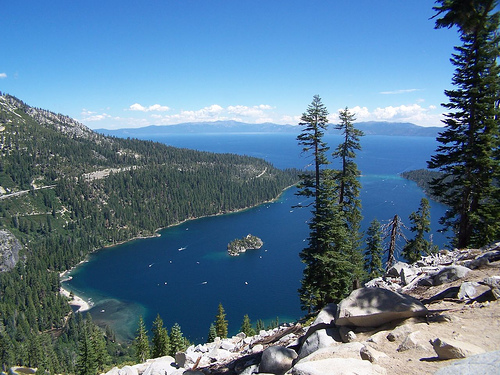
We've backpacked and off-road camped in the mountains many times (although not so much lately, unfortunately). The peaks and valleys of Yosemite, especially when the waterfalls are rushing during the spring snow melt, are well worth the three hour drive from the bay area. The 2400 ft Yosemite Falls is the tallest in the North America. Unfortunately most tourists only have the time (and physical endurance) to visit the Yosemite Valley floor -- less than 1% of the park area.
Further south, Kings Canyon contains groves of Giant Sequoia trees, the most massive trees in the world (redwoods are taller but not as massive). Mount Whitney, at 14,505 feet, is the tallest peak in the continental US.
Depending on how much snow the mountains receive over the winter, many of the roads and passes may not open until July.
And more…
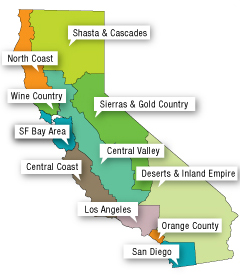 California
is a large and diverse state, and after living here for almost 20 years there
are still many areas we want to visit.
California
is a large and diverse state, and after living here for almost 20 years there
are still many areas we want to visit.
For anything not covered above, or for more details and resources, check out the SF Gate’s comprehensive Visitor’s Guide, or for an interesting tour by San Francisco neighborhood, visit their SF Neighborhood Guide.
For a general overview of California tourism throughout the state, see the official Visit California website.

